November itinerary in Japan Day 1 (Nagasaki Day 1 Meal edition)
(Monday, November 15th)
Table of contents
1. Turkish rice
The meal for this trip to Nagasaki and Fukuoka was a turbulent start. I arrived at Nagasaki Station at 10:38. The departure time of the high-speed ship “Shunkan” bound for Takashima was 11:50, so it was necessary to have lunch immediately. However, when I searched for stores that opened at 11:00 around Nagasaki Station and Nagasaki Port Terminal, I couldn’t find them, and all of them opened at 11:30. When I entered the restaurant at 11:30, I could miss the high-speed boat, so I had to choose to buy a lunch box at a convenience store.
At the convenience store “Daily Yamazaki” near the Nagasaki Port Terminal, I bought a “Turkish Rice” lunch box, which is a local gourmet of Nagasaki, and decided to eat it on a high-speed boat. Turkish rice is a dish of Japanese pork cutlet, Chinese pilaf, and Western spaghetti served together on a plate. There is a theory that the name Turkish Rice was given because the mixed feeling of Japanese food, Chinese food, and Western food leads to Turkey where East and West cultures intersect. Shippoku ryori, a local dish of Nagasaki, is also characterized by having Japanese, Chinese, and Western dishes on the table, so it can be called a modern version of Shippoku ryori.

I have been to Turkey, but there is no food like Turkish rice in Turkey. In the first place, Turks who are Muslims do not eat pork. It is a kind of food that the Japanese gave a foreign place name so that there is no Napolitan in Napoli (Naples) and there is no (Japanese) Taiwan ramen in Taiwan. However, I think foreigners are confused by these unique names. I think Japanese people give too many foreign place names to their dishes.
In 2010, Nagasaki City set September 16th as “Turkish Rice Day”. September 16th is the day when the Turkish warship Ertuğrul was distressed and 587 people died. However, as mentioned earlier, there is no custom of eating pork in Turkey, and the Turkish embassy asked Nagasaki City about the purpose of making the day when many Turkish victims came out “Turkish Rice Day”. As a result, Nagasaki City canceled “Turkish Rice Day” in 2013. It was a very embarrassing and poor incident. If we want to easily give a foreign name or a foreign place name, we need to be careful enough, and “Turkish Rice Day” should be a lesson.
I don’t think many Japanese know about the distress of the Turkish warship Ertuğrul, so I will briefly summarize the distress cases. On September 16, 1890, the Ertuğrul, which came to Japan as the first Ottoman delegation to Japan, crashed into a reef off the coast of Oshima Village (now Kushimoto Town) on Kii Oshima and sank on its way back to Turkey. The people of Oshima Village worked hard to rescue 69 people. Turkey still has a good impression of Japan and the Japanese people about this rescue operation. It is said that this distress case triggered Turkey to be one of the most pro-Japanese countries in the world.
In addition, even after more than 100 years have passed since the distress incident, many Turkish students are taught this distress incident and Japanese rescue activities in Turkish textbooks. In return for that, Turkey saved the Japanese escape from Iran-Tehran by a rescue plane during the Iran-Iraq War. Also, when I traveled to Turkey, many Turkish people feasted on food and fruits just because I was Japanese.
Returning to the story, the Turkish rice lunch box of “Daily Yamazaki” was cheap at Yen 432 including tax. I was worried about the taste because of the low price, but the taste was good enough. I think it is the ability of Japanese convenience stores to offer this level of taste at this price. It is fresh in our memory that foreign journalists were delighted to eat at convenience stores in Japan at the Tokyo Olympics and Paralympics.
There was also a lounge and a table on the high-speed ship, so I was able to gracefully eat Turkish rice while looking at the beautiful sea view. The first meal of the trip was turbulent, but as a result, I’m glad I was able to eat delicious Turkish rice, which is a local gourmet in Nagasaki. However, as a Japanese, I will not forget about “Turkish Rice Day”.
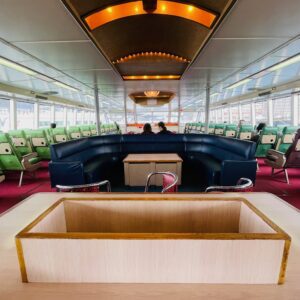
2. Yossou
After visiting Sofukuji Temple, I had a dinner at “Yossou”. “Yossou” was opened in 1866 by the founder, Muneyoshi Yoshida, under the name of Yossou, as a restaurant specializing in chawan-mushi (a custard-like egg and vegetable dish steamed in a cup) and steamed sushi. It is a historic restaurant that was founded two years before the Meiji Restoration (1868). Not only is it a long-established restaurant, but it is still the restaurant with the second highest rating in Nagasaki City (8th in Nagasaki Prefecture) in Tabelog,gourmet website. It is wonderful that it does not rely on goodwill.
The current building is a historic building built in 1927 (Showa 2). It was extensively renovated in 2012, and while the exterior of the building retains its atmosphere, the interior is a cozy Japanese space.
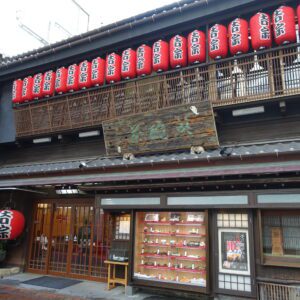
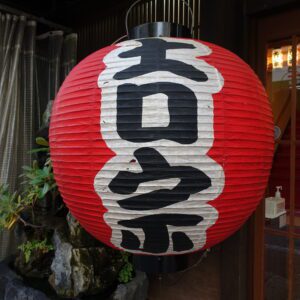
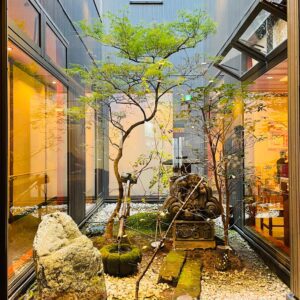
I ate “Yossou set meal” (Yen 2,420). A set meal with traditional Yossou chawan-mushi, steamed sushi, and pork kakuni (Touba-Stew, which is also included in the shippoku ryori) and small bowls (boiled sharkfin, kinpira-style sauteed burdock, pickled turnip, and orange). I thought it would take time to serve steamed dishes such as chawan-mushi, but since the heat was kept in the bamboo steamer, the serving time was surprisingly fast, about 5 minutes.
In the past, Yossou used to serve shippoku ryori, but unfortunately it has been suspended. Especially, the hot chawan-mushi was delicious with a lot of ingredients (conger eel, shrimp, chicken, shiitake mushrooms, ginkgo, etc.). I thought it was a wonderful restaurant that can offer traditional tastes even in modern times. Staff of the restaurant was also friendly and the service was excellent.
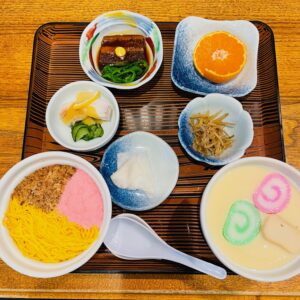
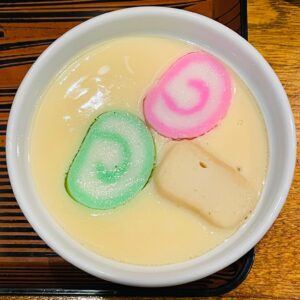
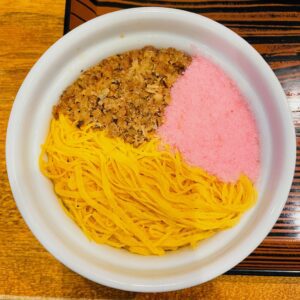
3. Tarafuku Asa
I didn’t eat fish and shellfish, which is the main purpose of this trip, so I went to the izakaya “Tarafuku Asa” after “Yossou”. I went to “Tarfuku Asa” during my last trip to Nagasaki, but I visited again because the food was very delicious and the service of the staff was good.
“Tarafuku Asa” is a “young” restaurant unlike “Yossou”. The store’s homepage says it has been in business for 32 years. The “young” restaurant I say is not the number of years it was founded, but the fact that all the staff (including cooks) are young in age. Probably everyone is in their twenties or early thirties. I think it’s wonderful that only these young people can run a popular restaurant. The education of employees, including part-time workers, is very solid. It makes me happy to enter such a lively izakaya. The Asa Group has 7 stores in Nagasaki City, but it is a recommended izakaya group for dining in Nagasaki.
At “Tarafuku Asa”, I ate assorted sashimi (flounder, live mackerel, amberjack, bonito, marlin, octopus, squid, scallop, ark shell), live mackerel sashimi, ginkgo nuts, and “kin-fugu” shiso tempura. The sashimi platter was from 2 people, but they also made it for 1 person. Nagasaki’s seafood, which has the second largest coastline in Japan and has a large catch, was really delicious.
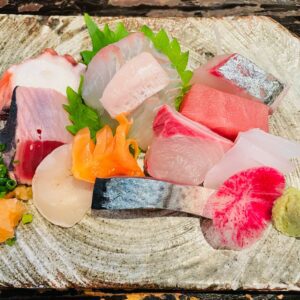
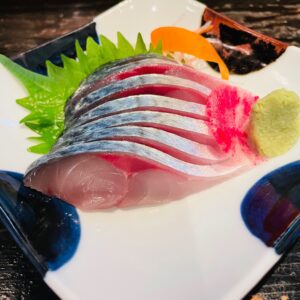
When eating sashimi in Nagasaki prefecture, it is important to remember that both soy sauce and sake are sweet as a prior knowledge. Due to the existence of Dejima in Nagasaki, it was possible to trade with foreign countries even under the isolation of the Edo period, and sugar was imported. The sugar was transported to Kyoto, Osaka, and Edo via Saga and Kokura. The highway connecting Nagasaki and Kokura is called the Nagasaki Kaido (Highway) , and it is called the “Sugar Road” because it carried a lot of sugar. This is the reason why there are many sweets using sugar such as castella in Nagasaki. Due to this historical background, sweets are preferred, and it is thought that both soy sauce and sake are often sweet.
The tendency to prefer this sweetness is not limited to Nagasaki Prefecture, but can be said for Kyushu as a whole. Fish and shellfish caught in Kyushu and horse sashimi from Kumamoto go well with sweet soy sauce. Eating local specialties with local seasonings is probably the most delicious way to eat.
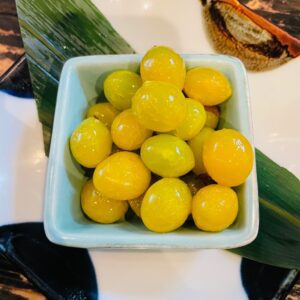
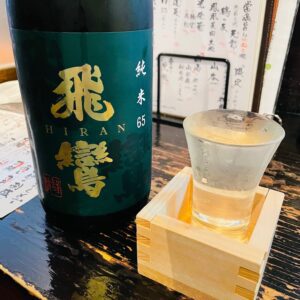
“Kin-fugu” is half-smooth golden pufferfish. It was branded as “Miyazaki Kin-fugu” in Miyazaki Prefecture. “Kin-fugu” I ate on that day was from Tsushima, but I think they wrote “Kin-fugu” on the menu because of the brand “Kin-fugu” in Miyazaki prefecture. In Fukuoka Prefecture, it is called “Kanato-fugu” (season is from August to December), and Japan Fisheries Cooperatives has selected it as the autumn “PRIDE FISH” in Fukuoka Prefecture.
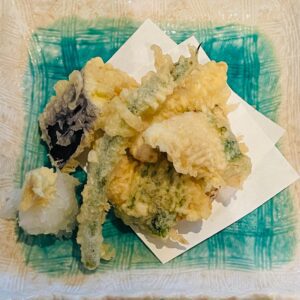
There are strong silvery individuals and golden individuals in half-smooth golden pufferfish. In Miyazaki Prefecture, only those with a golden fish body that have no scratches on the outside are shipped as “Miyazaki Kin-fugu”. Half-smooth golden pufferfish is a rare type of blowfish whose body, skin and internal organs are non-toxic. This time, I was able to eat delicious “Kin-fugu” just in season.
Many customers came to “Tarafuku Asa” after 6 pm, but most of them were refused because they were fully booked. This popularity is amazing even on Mondays when most people don’t go to the izakaya. I went to the store at 17:00 as I did last time, so I entered without a reservation, but I think it’s better to make a reservation.
Note: The departure / arrival times and fares of transportation, facility admission fees, meal fees, etc. listed in the text are as of the time of writing the BLOG. Please check for yourself when you go on a trip as it may change in the future.
